Angiotensin II and EDH Pathways Underlie the Vascular Sympatho-Modulation by 5-HT in Female Rats
Abstract
1. Introduction
2. Results
2.1. Systemic Hemodynamic Parameters
2.2. Effect of Saline or 5-HT Receptor Agonists: L-694,247, TCB-2, and 1-PBG on the Vasopressor Responses Induced by Electrical Stimulation in Female Rats
2.3. Influence of i.v. Bolus of Vehicles or Antagonists (Indomethacin, L-NAME, TEA, Sulfisoxazole, or Losartan) per se on the Vasopressor Responses Induced by Electrical Stimulation in Female Rats
2.4. Impact of i.v. Administration of Indomethacin, L-NAME, or TEA on the L-694,247-Induced Serotonergic Sympatho-Inhibitory Effect in Female Rats
2.5. Influence of i.v. Administration of Indomethacin, Sulfisoxazole, or Losartan on the TCB-2 or 1-PBG Sympathetic Potentiation in Female Rats
2.6. Plasma Concentration of Ang-II
3. Discussion
3.1. Basal Hemodynamic Parameters in Female Rats
3.2. Indirect Mechanisms Involved in 5-HT Vascular Sympatho-Inhibition in Female Rats
3.3. Indirect Mechanisms Involved in 5-HT Vascular Sympatho-Potentiation in Female Rats
3.4. Limitations and Clinical Perspectives
4. Materials and Methods
4.1. Drugs Used
4.2. Animals
4.3. Surgical Procedure and Animal Preparation
4.4. Vascular Sympathetic Stimulation in Female Rats
4.5. Plasma Ang-II Determination
4.6. Data Presentation and Statistical Analysis
5. Conclusions
Author Contributions
Funding
Institutional Review Board Statement
Data Availability Statement
Acknowledgments
Conflicts of Interest
Abbreviations
| ∆MBP | Increases in MBP |
| 1-PBG | 1- phenylbiguanide |
| 5-HT | 5-hydroxytryptamine, Serotonin |
| Ang-II | Angiotensin II |
| AT1 receptor | Ang-II type 1 receptor |
| CNS | Central nervous system |
| COX | Cyclooxygenase |
| CVD | Cardiovascular diseases |
| EDH | Endothelium-dependent hyperpolarization |
| HR | Heart rate |
| L-NAME | N(ω)-nitro-L-arginine methyl ester |
| MBP | Mean blood pressure |
| NO | Nitric oxide |
| NOS | Nitric oxide synthase |
| PEN | Polyethylene glycol (33%), ethanol (33%), NaOH 0.2 M (34%) |
| SNS | Sympathetic nervous system |
| S-R curve | Stimulation–response curve |
| TEA | Tetraethylammonium |
References
- Côté, F.; Fligny, C.; Fromes, Y.; Mallet, J.; Vodjdani, G. Recent advances in understanding serotonin regulation of cardiovascular function. Trends Mol. Med. 2024, 10, 232–238. [Google Scholar] [CrossRef]
- Morán, A.; Velasco, C.; Martín, M.L.; San Román, L. Renal vasoconstrictor response to 5-hydroxytryptamine in the in situ autoperfused rat kidney: Involvement of angiotensin II and the 5-HT2 receptor activation. Eur. J. Pharmacol. 1997, 330, 205–211. [Google Scholar] [CrossRef]
- Restrepo, B.; García, M.; Rodríguez-Barbero, A.; Román, L.S.; Martin, M.L.; Morán, A. Participation of cyclooxygenase pathway in the vasoconstriction induced by 5-HT in the in situ autoperfused kidney of long-term diabetic rats. Eur. J. Pharmacol. 2011, 659, 37–44. [Google Scholar] [CrossRef] [PubMed]
- García-Pedraza, J.A.; García, M.; Martín, M.L.; Rodríguez-Barbero, A.; Morán, A. 5-HT2 receptor blockade exhibits 5-HT vasodilator effects via nitric oxide, prostacyclin and ATP-sensitive potassium channels in rat renal vasculature. Vasc. Pharmacol. 2016, 79, 51–59. [Google Scholar] [CrossRef] [PubMed]
- Cuesta, C.; García-Pedraza, J.Á.; García, M.; Villalón, C.M.; Morán, A. Role of 5-HT7 receptors in the inhibition of the vasodepressor sensory CGRPergic outflow in pithed rats. Vasc. Pharmacol. 2014, 63, 4–12. [Google Scholar] [CrossRef] [PubMed]
- García-Pedraza, J.Á.; García, M.; Martín, M.L.; Gómez-Escudero, J.; Rodríguez-Barbero, A.; Román, L.S.; Morán, A. Peripheral 5-HT1D and 5-HT7 serotonergic receptors modulate sympathetic neurotransmission in chronic sarpogrelate treated rats. Eur. J. Pharmacol. 2013, 714, 65–73. [Google Scholar] [CrossRef]
- García-Pedraza, J.Á.; López, C.; Fernández-González, J.F.; Martín, M.L.; Morán, A.; García-Domingo, M. Vascular sympathetic neurotransmission and its serotonergic regulation are modified by chronic fluoxetine treatment. J. Pharmacol. Sci. 2021, 147, 48–57. [Google Scholar] [CrossRef]
- García-Pedraza, J.Á.; Fernández-González, J.F.; López, C.; Martín, M.L.; Alarcón-Torrecillas, C.; Rodríguez-Barbero, A.; Morán, A.; García-Domingo, M. Oral fluoxetine treatment changes serotonergic sympatho-regulation in experimental type 1 diabetes. Life Sci. 2022, 293, 120335. [Google Scholar] [CrossRef]
- Fernández-González, J.F.; García-Pedraza, J.Á.; Ordóñez, J.L.; Terol-Úbeda, A.C.; Martín, M.L.; Morán, A.; García-Domingo, M. Renal sympathetic hyperactivity in diabetes is modulated by 5-HT1D receptor activation via NO pathway. Int. J. Mol. Sci. 2023, 24, 1378. [Google Scholar] [CrossRef]
- Fernández-González, J.F.; García-Pedraza, J.Á.; Terol-Úbeda, A.C.; Martín, M.L.; Morán, A.; García-Domingo, M. Chronic sarpogrelate treatment improves renal sympathetic hyperactivity in experimental diabetes. Biomed. Pharmacother. 2024, 176, 116814. [Google Scholar] [CrossRef]
- Dalla, C.; Pitychoutis, P.M.; Kokras, N.; Papadopoulou-Daifoti, Z. Sex differences in animal models of depression and antidepressant response. Basic Clin. Pharmacol. Toxicol. 2010, 106, 226–233. [Google Scholar] [CrossRef]
- Chen, Y.; Cai, W.; Li, C.; Su, Z.; Guo, Z.; Li, Z.; Wang, C.; Xu, F. Sex differences in peripheral monoamine transmitter and related hormone levels in chronic stress mice with a depression-like phenotype. PeerJ 2022, 10, e14014. [Google Scholar] [CrossRef]
- Araldi, D.; Ferrari, L.F.; Green, P.; Levine, J.D. Marked sexual dimorphism in 5-HT1 receptors mediating pronociceptive effects of sumatriptan. Neuroscience 2017, 344, 394–405. [Google Scholar] [CrossRef] [PubMed]
- Pais, M.L.; Martins, J.; Castelo-Branco, M.; Gonçalves, J. Sex differences in tryptophan metabolism: A systematic review focused on neuropsychiatric disorders. Int. J. Mol. Sci. 2023, 24, 6010. [Google Scholar] [CrossRef] [PubMed]
- Lokuge, S.; Frey, B.N.; Foster, J.A.; Soares, C.N.; Steiner, M. The rapid effects of estrogen: A mini-review. Behav. Pharmacol. 2010, 21, 465–472. [Google Scholar] [CrossRef] [PubMed]
- Lasiuk, G.C.; Hegadoren, K.M. The effects of estradiol on central serotonergic systems and its relationship to mood in women. Biol. Res. Nurs. 2007, 9, 147–160. [Google Scholar] [CrossRef]
- Spinieli, R.L.; Cornelius-Green, J.; Cummings, K.J. A serotonin-deficient rat model of neurogenic hypertension: Influence of sex and sympathetic vascular tone. J. Neurophysiol. 2022, 128, 1199–1206. [Google Scholar] [CrossRef]
- Terol-Úbeda, A.C.; Fernández-González, J.F.; Roldán-Hernández, C.A.; Martín, M.L.; Morán, A.; García-Domingo, M.; García-Pedraza, J.Á. Sex influence on serotonergic modulation of the vascular noradrenergic drive in rats. Br. J. Pharmacol. 2025, 182, 1025–1037. [Google Scholar] [CrossRef]
- Morán, A.; Velasco, C.; Salvador, T.; Martín, M.L.; San Román, L. Inhibitory 5-hydroxytryptamine receptors involved in pressor effects obtained by stimulation of sympathetic outflow from spinal cord in pithed rats. Br. J. Pharmacol. 1994, 113, 1358–1362. [Google Scholar] [CrossRef]
- Morán, A.; Fernández, M.M.; Velasco, C.; Martín, M.L.; San Román, L. Characterization of prejunctional 5-HT1 receptors that mediate the inhibition of pressor effects elicited by sympathetic stimulation in the pithed rat. Br. J. Pharmacol. 1998, 123, 1205–1213. [Google Scholar] [CrossRef]
- Rajendran, A.; Minhas, A.S.; Kazzi, B.; Varma, B.; Choi, E.; Thakkar, A.; Michos, E.D. Sex-specific differences in cardiovascular risk factors and implications for cardiovascular disease prevention in women. Atherosclerosis 2023, 384, 117269. [Google Scholar] [CrossRef]
- Gersh, F.; O’Keefe, J.H.; Elagizi, A.; Lavie, C.J.; Laukkanen, J.A. Estrogen and cardiovascular disease. Prog. Cardiovasc. Dis. 2024, 84, 60–67. [Google Scholar] [CrossRef]
- Guo, X.; Razandi, M.; Pedram, A.; Kassab, G.; Levin, E.R. Estrogen induces vascular wall dilation: Mediation through kinase signaling to nitric oxide and estrogen receptors alpha and beta. J. Biol. Chem. 2005, 280, 19704–19710. [Google Scholar] [CrossRef]
- Scotland, R.S.; Madhani, M.; Chauhan, S.; Moncada, S.; Andresen, J.; Nilsson, H.; Hobbs, A.J.; Ahluwalia, A. Investigation of vascular responses in endothelial nitric oxide synthase/cyclooxygenase-1 double-knockout mice: Key role for endothelium-derived hyperpolarizing factor in the regulation of blood pressure in vivo. Circulation 2005, 111, 796–803. [Google Scholar] [CrossRef]
- Small, H.Y.; McNeilly, S.; Mary, S.; Sheikh, A.M.; Delles, C. Resistin mediates sex-dependent effects of perivascular adipose tissue on vascular function in the SHRSP. Sci. Rep. 2019, 9, 6897. [Google Scholar] [CrossRef] [PubMed]
- Sartori-Valinotti, J.C.; Iliescu, R.; Yanes, L.L.; Dorsett-Martin, W.; Reckelhoff, J.F. Sex differences in the pressor response to angiotensin II when the endogenous renin-angiotensin system is blocked. Hypertension 2008, 51, 1170–1176. [Google Scholar] [CrossRef] [PubMed]
- Shukri, M.Z.; Tan, J.W.; Manosroi, W.; Pojoga, L.H.; Rivera, A.; Williams, J.S.; Seely, E.W.; Adler, G.K.; Jaffe, I.Z.; Karas, R.H.; et al. Biological sex modulates the adrenal and blood pressure responses to angiotensin II. Hypertension 2018, 71, 1083–1090. [Google Scholar] [CrossRef] [PubMed]
- Xue, B.; Pamidimukkala, J.; Hay, M. Sex differences in the development of angiotensin II-induced hypertension in conscious mice. Am. J. Physiol. Heart Circ. Physiol. 2005, 288, H2177–H2184. [Google Scholar] [CrossRef]
- García, M.; Morán, A.; Martín, M.L.; Barthelmebs, M.; San Román, L. The nitric oxide synthesis/pathway mediates the inhibitory serotoninergic responses of the pressor effect elicited by sympathetic stimulation in diabetic pithed rats. Eur. J. Pharmacol. 2006, 537, 126–134. [Google Scholar] [CrossRef]
- Restrepo, B.; García, M.; López, C.; Martín, M.L.; San Román, L.; Morán, A. The cyclooxygenase and nitric oxide synthesis/pathways mediate the inhibitory serotonergic response to the pressor effect elicited by sympathetic stimulation in long-term diabetic pithed rats. Pharmacology 2012, 90, 169–176. [Google Scholar] [CrossRef]
- García-Pedraza, J.Á.; García, M.; Martín, M.L.; San Román, L.; Morán, A. The role of endothelium-derived hyperpolarizing factor and cyclooxygenase pathways in the inhibitory serotonergic response to the pressor effect elicited by sympathetic stimulation in chronic sarpogrelate treated rats. Eur. J. Pharmacol. 2014, 731, 80–87. [Google Scholar] [CrossRef]
- Fernández-González, J.F.; García-Pedraza, J.Á.; Marín-Quílez, A.; Bastida, J.M.; Martín, M.L.; Morán, A.; García-Domingo, M. Effect of sarpogrelate treatment on 5-HT modulation of vascular sympathetic innervation and platelet activity in diabetic rats. Biomed. Pharmacother. 2022, 153, 113276. [Google Scholar] [CrossRef]
- Cardoso, F.; Fávero, M.T.; Veríssimo, N.V.; Furtado Menezes, M.; Menani, J.V.; de Paula, P.M. Participation of the angiotensinergic and vasopressinergic mechanisms in the maintenance of cardiorespiratory parameters in sodium depleted rats. Heliyon 2022, 8, e12221. [Google Scholar] [CrossRef] [PubMed]
- Nagatomo, T.; Rashid, M.; Abul Muntasir, H.; Komiyama, T. Functions of 5-HT2A receptor and its antagonists in the cardiovascular system. Pharmacol. Ther. 2004, 104, 59–81. [Google Scholar] [CrossRef] [PubMed]
- Lin, S.L.; Setya, S.; Johnson-Farley, N.N.; Cowen, D.S. Differential coupling of 5-HT(1) receptors to G proteins of the G(i) family. Br. J. Pharmacol. 2002, 136, 1072–1078. [Google Scholar] [CrossRef] [PubMed]
- Vanhoutte, P.M.; Shimokawa, H.; Feletou, M.; Tang, E.H. Endothelial dysfunction and vascular disease-A 30th anniversary update. Acta Physiol. 2017, 219, 22–96. [Google Scholar] [CrossRef]
- Tang, E.H.C.; Vanhoutte, P.M. Endothelial dysfunction: A strategic target in the treatment of hypertension? Pflug. Arch.-Eur. J. Physiol. 2010, 459, 995–1004. [Google Scholar] [CrossRef]
- Medina-Terol, G.J.; Huerta de la Cruz, S.; Beltran-Ornelas, J.H.; Sánchez-López, A.; Centurión, D. Pharmacological evidence that potassium channels mediate hydrogen sulfide-induced inhibition of the vasopressor sympathetic outflow in pithed rats. Eur. J. Pharmacol. 2022, 931, 175160. [Google Scholar] [CrossRef]
- García-Pedraza, J.Á.; García, M.; Martín, M.L.; Morán, A. 5-HT1D receptor inhibits renal sympathetic neurotransmission by nitric oxide pathway in anesthetized rats. Vasc. Pharmacol. 2015, 72, 172–180. [Google Scholar] [CrossRef]
- Simaan, J.; Sabra, R. In-vivo evidence of a role for nitric oxide in regulating the activity of the norepinephrine transporter. Eur. J. Pharmacol. 2011, 671, 102–106. [Google Scholar] [CrossRef]
- Hinton, J.M.; Langton, P.D. Inhibition of EDHF by two new combinations of K+-channel inhibitors in rat isolated mesenteric arteries. Br. J. Pharmacol. 2003, 138, 1031–1035. [Google Scholar] [CrossRef]
- Coleman, H.A.; Tare, M.; Parkington, H.C. Endothelial potassium channels, endothelium-dependent hyperpolarization and the regulation of vascular tone in health and disease. Clin. Exp. Pharmacol. Physiol. 2004, 31, 641–649. [Google Scholar] [CrossRef]
- Villar, I.C.; Hobbs, A.J.; Ahluwalia, A. Sex differences in vascular function: Implication of endothelium-derived hyperpolarizing factor. J. Endocrinol. 2008, 197, 447–462. [Google Scholar] [CrossRef] [PubMed]
- Pak, K.J.; Geary, G.G.; Duckles, S.P.; Krause, D.N. Male-female differences in the relative contribution of endothelial vasodilators released by rat tail artery. Life Sci. 2002, 71, 1633–1642. [Google Scholar] [CrossRef] [PubMed]
- Liu, M.Y.; Hattori, Y.; Sato, A.; Ichikawa, R.; Zhang, X.H.; Sakuma, I. Ovariectomy attenuates hyperpolarization and relaxation mediated by endothelium-derived hyperpolarizing factor in female rat mesenteric artery: A concomitant decrease in connexin-43 expression. J. Cardiovasc. Pharmacol. 2002, 40, 938–948. [Google Scholar] [CrossRef] [PubMed]
- Xu, H.L.; Ye, S.; Baughman, V.L.; Feinstein, D.L.; Pelligrino, D.A. The role of the glia limitans in ADP-induced pial arteriolar relaxation in intact and ovariectomized female rats. Am. J. Physiol. Heart Circ. Physiol. 2005, 288, H382–H388. [Google Scholar] [CrossRef]
- Thompson, A.J.; Lummis, S.C.R. The 5-HT3 receptor as a therapeutic target. Expert Opin. Ther. Targets 2007, 11, 527–540. [Google Scholar] [CrossRef]
- Hoyer, D.; Hannon, J.P.; Martin, G.R. Molecular, pharmacological and functional diversity of 5-HT receptors. Pharmacol. Biochem. Behav. 2002, 71, 533–554. [Google Scholar] [CrossRef]
- Goldberg, E.; Grau, J.B.; Fortier, J.H.; Salvati, E.; Levy, R.J.; Ferrari, G. Serotonin and catecholamines in the development and progression of heart valve diseases. Cardiovasc. Res. 2017, 113, 849–857. [Google Scholar] [CrossRef]
- Perez, J.; Diaz, N.; Tandon, I.; Plate, R.; Martindale, C.; Balachandran, K. Elevated serotonin interacts with angiotensin-II to result in altered valve interstitial cell contractility and remodeling. Cardiovasc. Eng. Technol. 2018, 9, 168–180. [Google Scholar] [CrossRef]
- Farrell, M.C.; Giza, R.J.; Shibao, C.A. Race and sex differences in cardiovascular autonomic regulation. Clin. Auton. Res. 2020, 30, 371–379. [Google Scholar] [CrossRef]
- Baker, S.E.; Limberg, J.K.; Ranadive, S.M.; Joyner, M.J. Neurovascular control of blood pressure is influenced by aging, sex, and sex hormones. Am. J. Physiol. Regul. Integr. Comp. Physiol. 2016, 311, R1271–R1275. [Google Scholar] [CrossRef]
- Percie du Sert, N.; Hurst, V.; Ahluwalia, A.; Alam, S.; Avey, M.T.; Baker, M.; Browne, W.J.; Clark, A.; Cuthill, I.C.; Dirnagl, U.; et al. The ARRIVE guidelines 2.0: Updated guidelines for reporting animal research. PLoS Biol. 2020, 18, e3000410. [Google Scholar] [CrossRef]

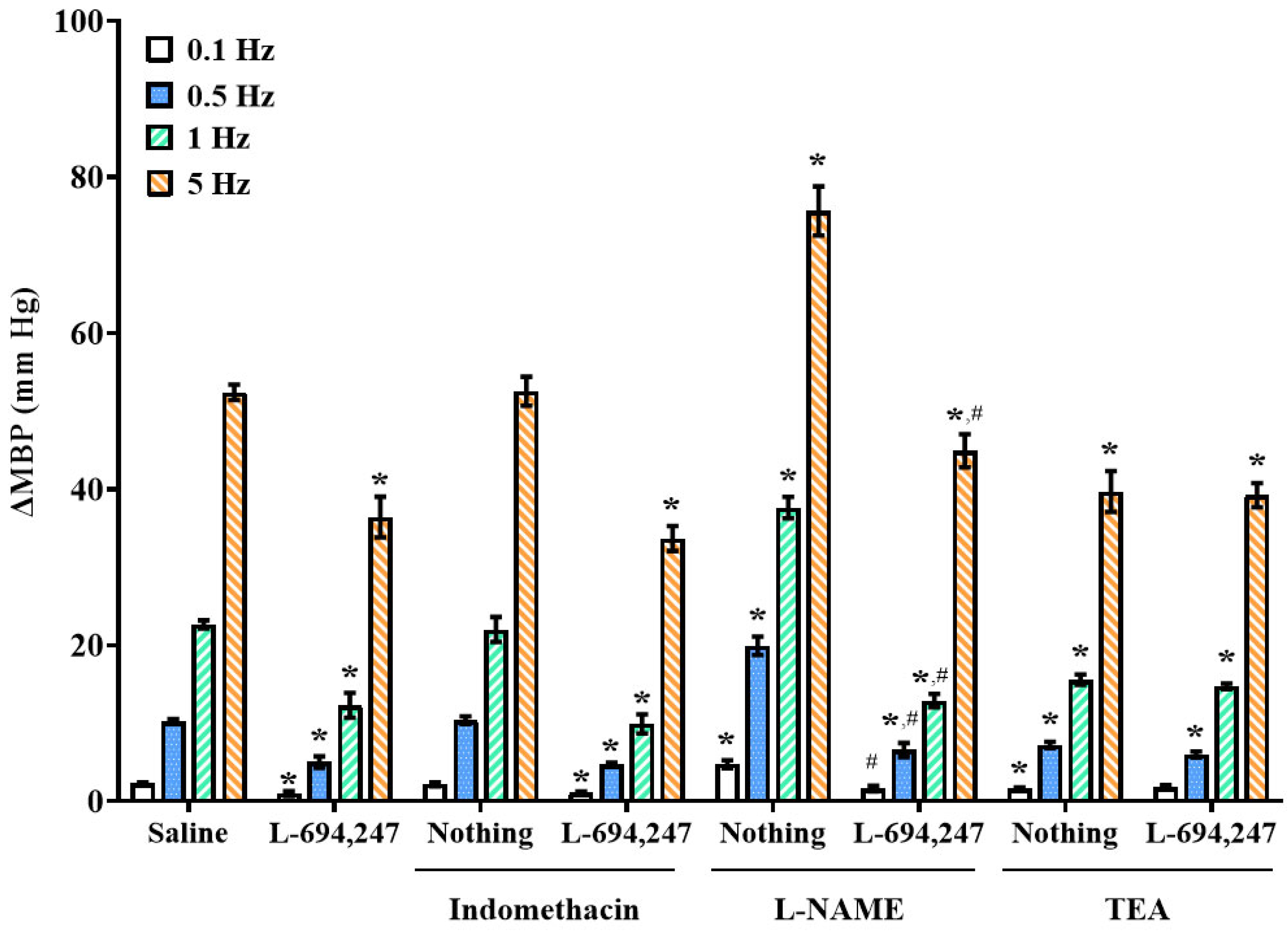
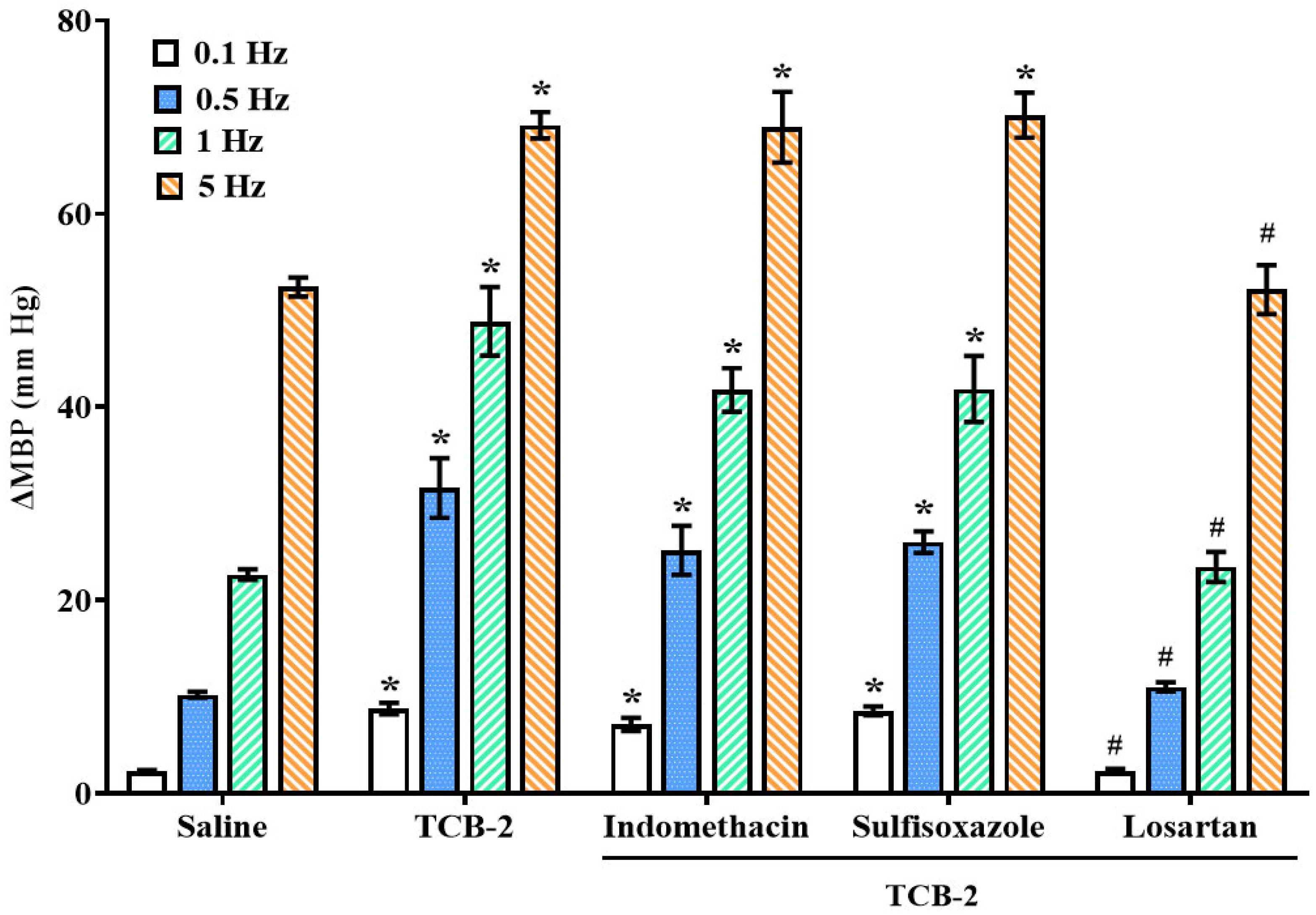
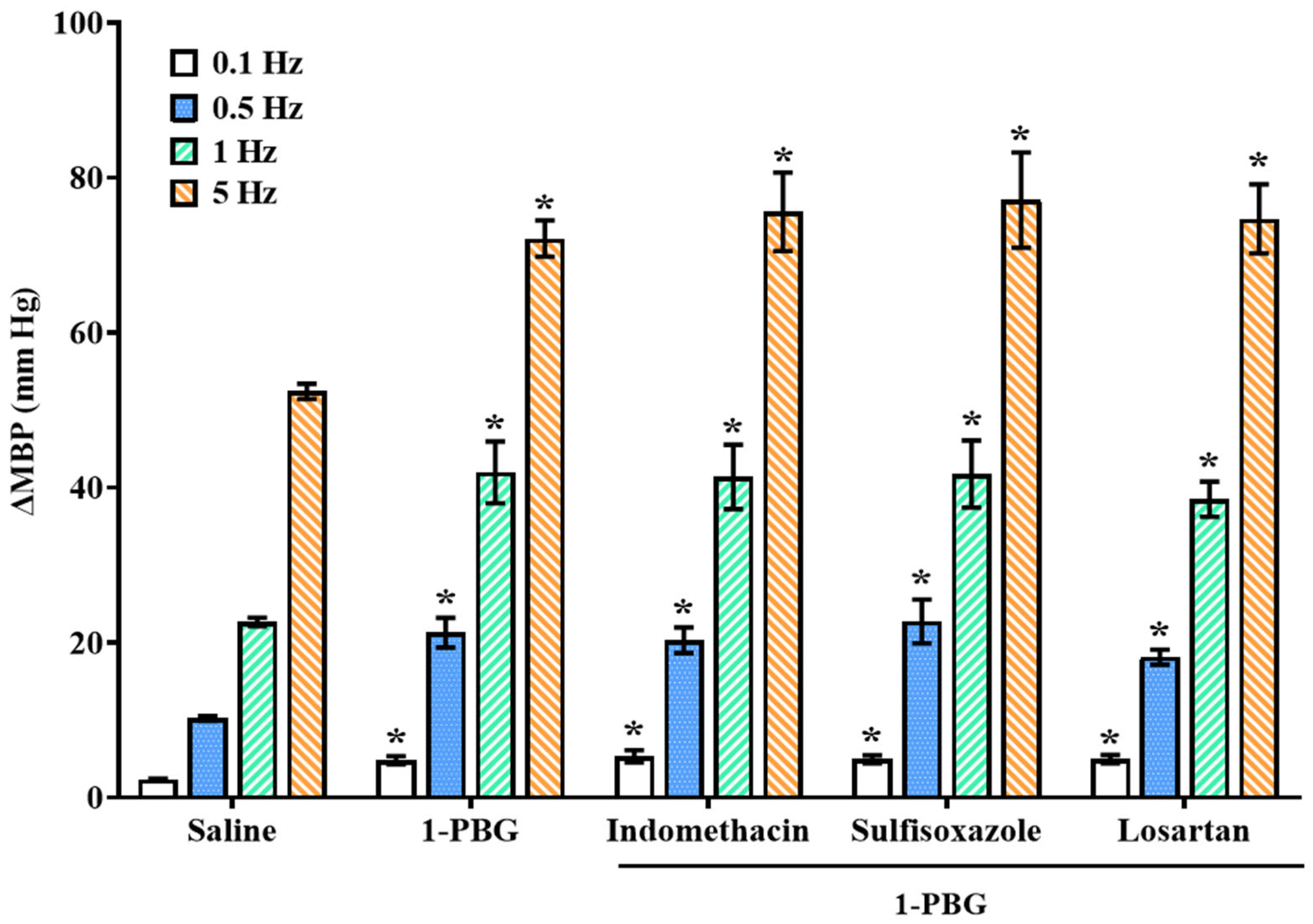
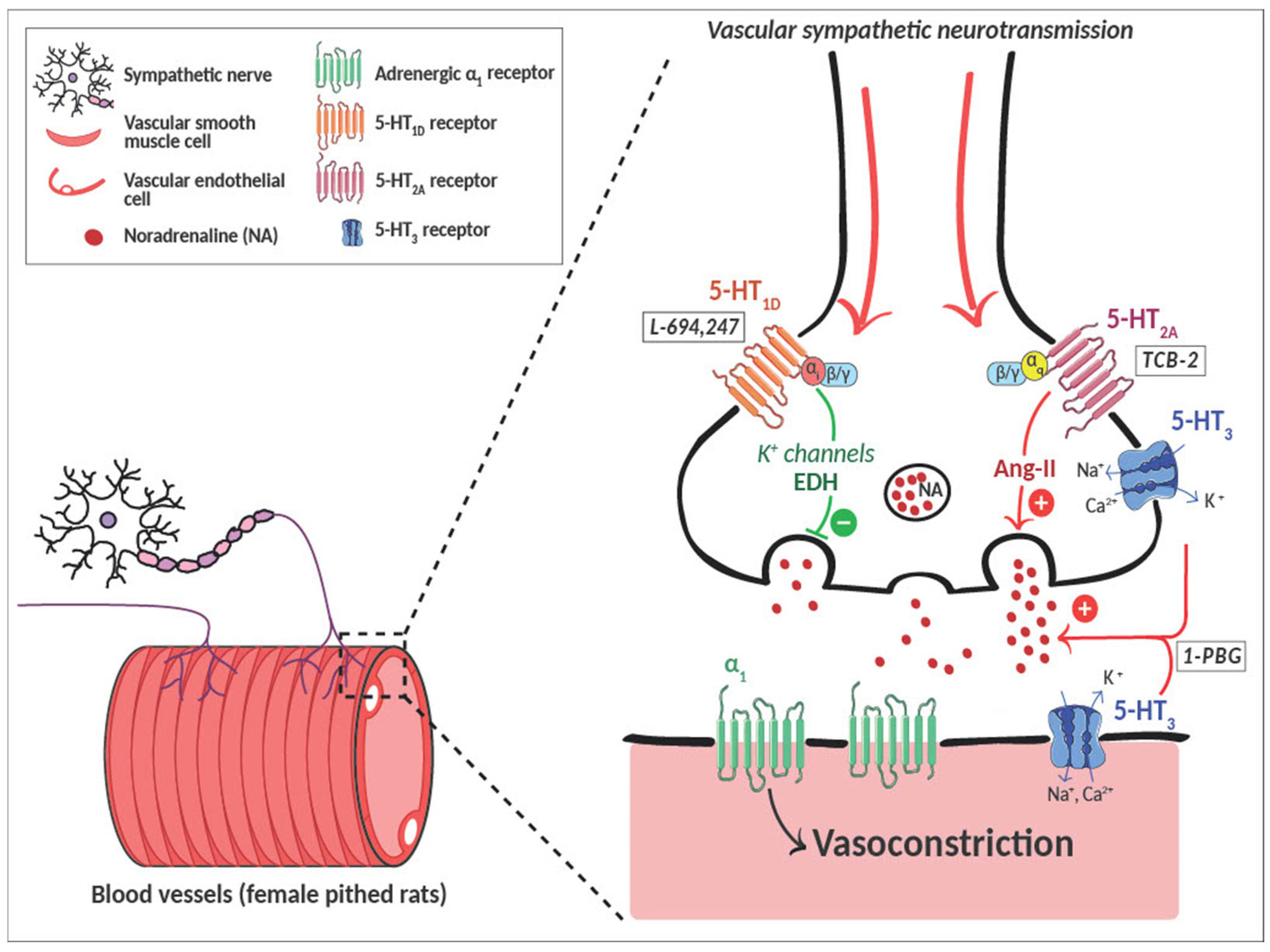
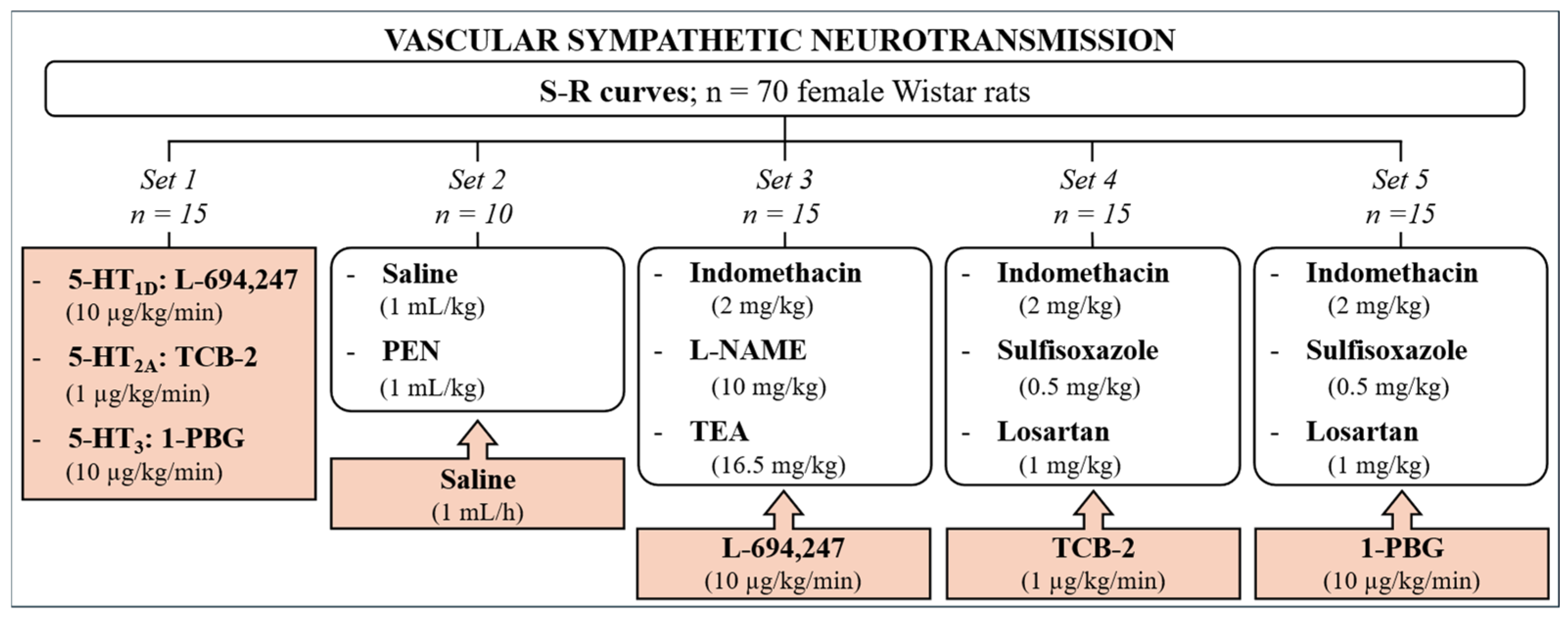
| Drug | Dose (mg/kg) | ∆MBP (mm Hg) | ∆HR (bpm) | |
|---|---|---|---|---|
| i.v. bolus Antagonists | Indomethacin | 2 | 0.7 ± 1.3 | 7.5 ± 9.9 |
| L-NAME | 10 | 42.8 ± 12 * | 0.3 ± 10.1 | |
| TEA | 16.5 | −1.8 ± 1.2 | −44.5 ± 6.7 * | |
| Sulfisoxazole | 0.5 | −3.6 ± 1.0 | 17.9 ± 13.3 | |
| Losartan | 1 | 2.0 ± 1.1 | −5.7 ± 7.0 | |
| Drug | Dose (µg/kg/min) | ∆MBP (mm Hg) | ∆HR (bpm) | |
| i.v. perfusion 5-HT receptor agonists | L-694,247 | 10 | −1.0 ± 1.9 | 16.0 ± 7.9 |
| TCB-2 | 1 | 30.2 ± 7.1 * | 59.0 ± 11.7 * | |
| 1-PBG | 10 | 6.9 ± 1.3 | 90.0 ± 16.9 * |
| i.v. Bolus Administration (mg/kg) | Frequency of Stimulation (Hz) | |||
|---|---|---|---|---|
| 0.1 | 0.5 | 1 | 5 | |
| Nothing (control) | 2.2 ± 0.3 | 10.5 ± 0.5 | 24.8 ± 2.3 | 54.1 ± 3.8 |
| Indomethacin (2) | 2.2 ± 0.2 | 10.3 ± 0.5 | 22.0 ± 1.5 | 52.4 ± 2.0 |
| L-NAME (10) | 4.8 ± 0.5 * | 19.9 ± 1.2 * | 37.6 ± 1.4 * | 75.7 ± 3.1 * |
| TEA (16.5) | 1.7 ± 0.1 * | 7.2 ± 0.4 * | 15.6 ± 0.7 * | 39.7 ± 2.6 * |
| Sulfisoxazole (0.5) | 2.2 ± 0.2 | 10.5 ± 0.8 | 21.9 ± 1.2 | 52.9 ± 2.8 |
| Losartan (1) | 2.4 ± 0.1 | 10.7 ± 0.4 | 22.5 ± 0.7 | 53.8 ± 2.1 |
| ∆MBP (mm Hg) | ||||
Disclaimer/Publisher’s Note: The statements, opinions and data contained in all publications are solely those of the individual author(s) and contributor(s) and not of MDPI and/or the editor(s). MDPI and/or the editor(s) disclaim responsibility for any injury to people or property resulting from any ideas, methods, instructions or products referred to in the content. |
© 2025 by the authors. Licensee MDPI, Basel, Switzerland. This article is an open access article distributed under the terms and conditions of the Creative Commons Attribution (CC BY) license (https://creativecommons.org/licenses/by/4.0/).
Share and Cite
Terol-Úbeda, A.C.; Fernández-González, J.F.; Morán, A.; García-Domingo, M.; García-Pedraza, J.Á. Angiotensin II and EDH Pathways Underlie the Vascular Sympatho-Modulation by 5-HT in Female Rats. Int. J. Mol. Sci. 2025, 26, 9614. https://doi.org/10.3390/ijms26199614
Terol-Úbeda AC, Fernández-González JF, Morán A, García-Domingo M, García-Pedraza JÁ. Angiotensin II and EDH Pathways Underlie the Vascular Sympatho-Modulation by 5-HT in Female Rats. International Journal of Molecular Sciences. 2025; 26(19):9614. https://doi.org/10.3390/ijms26199614
Chicago/Turabian StyleTerol-Úbeda, Anaïs Clara, Juan Francisco Fernández-González, Asunción Morán, Mónica García-Domingo, and José Ángel García-Pedraza. 2025. "Angiotensin II and EDH Pathways Underlie the Vascular Sympatho-Modulation by 5-HT in Female Rats" International Journal of Molecular Sciences 26, no. 19: 9614. https://doi.org/10.3390/ijms26199614
APA StyleTerol-Úbeda, A. C., Fernández-González, J. F., Morán, A., García-Domingo, M., & García-Pedraza, J. Á. (2025). Angiotensin II and EDH Pathways Underlie the Vascular Sympatho-Modulation by 5-HT in Female Rats. International Journal of Molecular Sciences, 26(19), 9614. https://doi.org/10.3390/ijms26199614






